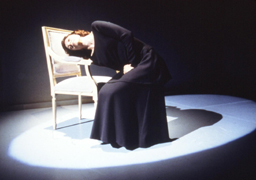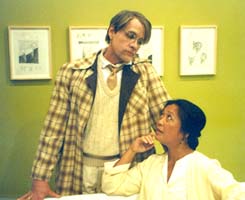
SCENE AND HEARD
by Randy Gener
Virginia Woolf's Return: "Room"
Based upon the writings of Virginia Woolf
Text adapted by Jocelyn Clark, created by the SITI Company
Classic Stage Company
136 East 13th Street in New York City, between 3rd and 4th Avenues, just
southeast of Union Square.
For tickets: (212)677-4210 x2
 |
| Ellen Lauren in "Room" at Classic Stage Company |
Woolf was avid to know more about other writers. Biographies were her favorite form of reading. She was always urging her women friends to set their life down on paper. But she herself was horrified of being exposed-of being put on display before an audience and of being mocked, laughed at and denigrated. She rarely gave public appearances and granted interviews. Writing with an acute sense of the past, Woolf hid behind the mask of fiction. "I must be private, secret, as anonymous and submerged as possible in order to write," she told a friend.
So it is ironical that Virginia Woolf should inspire yet another one-woman solo work, that most solipsistic of modern theatrical forms and the one most closely associated to dreary public confession. "Room" is a new 90-minute solo piece from the New York-based SITI Company. Adapted by the Irish writer Jocelyn Clark and staged by SITI Company artistic director Anne Bogart. The collage portrait draws largely from Woolf's popular 1929 essay "A Room of One's Own," with excerpts from her letters, fiction and other essays (like "A Sketch From the Past").
Beginning previews May 21 at the Classic Stage Company, "Room" reconnoiters the same classic feminist text that was adapted for the stage by Patrick Garland and famously performed by the British actress Eileen Atkins in London and New York. Garland's version continues to show strong legs. Atkins has toured it extensively since it debuted in 1989. A different version of it, with New York actress Tod Randolph portraying Woolf, is one of the featured productions of the 12th annual Conference on Virginia Woolf, which will be held June 6-9 at Sonoma State University in California.
Eileen Atkins, who bears an odd physical resemblance to Woolf, has staked an almost proprietary claim on the dramatizations of her literary writings. She adapted Woolf's diaries for a five-part BBC radio series. Several seasons ago Atkins created "Vita and Virginia," a theatre piece (not exactly a play) woven out of the letters of Woolf and her lover Vita Sackville-West. Atkins took on Woolf, with Vanessa Redgrave as Vita. Atkins also wrote the screenplay for the 1998 film adaptation of Woolf's shimmering 1925 novel "Mrs. Dalloway."
Not every one of Atkins' Woolfian forays has been successful -- "Vita and Virginia" felt dramatically inert, and the film "Mrs. Dalloway" never gathers to a contrapuntal whole -- but Atkins showed that, with intelligence and a special feeling for Woolf's expansive prose, it could be done. She is within reach. She is perhaps not so elusive and forbidding as we were meant to believe.
With a door left ajar, American artists -- as opposed to the usual roundtable of academics, critics, scholars and cult feminists -- have been drawn into deeper Woolfishness as well. And like Atkins' "Vita and Virginia," collage has been the preferred portraiture method. Woolf's words are pulled off the page, rearranged and then placed in new scenes that blend fact and fiction, biography and invention.
In 1998, Michael Cunningham won the Pulitzer Prize for his novel "The Hours." A canny homage to Woolf's "Mrs. Dalloway," "The Hours" opens with a haunting evocation of the day Woolf placed stones in her pockets and drowned herself in the River Ouse in 1941. Recreated from historical sources, "The Hours" dutifully renders the outward particulars of Woolf's suburban life at Hogarth House outside of London and boldly makes up her inner life (thoughts, feelings, conversations) on a fictional day in 1923 when she composes the first sentence for "Mrs. Dalloway." A film adaptation of "The Hours" -- starring Meryl Streep, Julianne Moore, Nicole Kidman, Ed Harris and (naturally) Eileen Atkins -- is tentatively set for limited release on October 4.
 |
| Stephen Nisbet and Mia Katigbak in "Love Seats for Virginia Woolf" |
Woolf and her four major friendships were the subjects of "Loveseats for Virginia Woolf," which refers to a furniture design exhibition by Brooklyn architect Annie Coggan and a two-person play by this writer which was produced by Item Design Laboratory and the National Asian American Company. This cross-disciplinary project, installed in a Brooklyn gallery, took the form of four love seats made up of white enamel-finished pieces of steel. In the evening, these art-objects doubled as a theatrical set for a chamber play that imagined Virginia Woolf's conversations with her husband Leonard Woolf, her painter-sister Vanessa Bell, her writer-friend Lytton Strachey and Vita Sackville-West. Just as in "The Hours" and "Room," the text for "Loveseats for Virginia Woolf" was a pastiche, this time constructed from letters, diary entries, fiction, short stories, essays, reviews and memoirs by friends and lovers.
Since "Room" and "Loveseats for Virginia Woolf" are conceptually oriented, they abandon the usual "Masterpiece Theatre"-style presentations of Woolf's character. They don't contrive, as "A Room of One's Own" and "Vita and Virginia" do, to offer audiences truthful re-creations or authentic evocations. These American versions of Woolf turn their back on the trick of impersonation and mimesis. Neither of the actors who portray Woolf in "Room" and "Loveseats" assumes her guise. Neither affects her subject's English accent, period dress or eccentric mannerisms. Both shows, one might say, draw anti-illusionist portraits. They present Woolf's consciousness in action.
A self-confessed Woolfian, the stage director Anne Bogart turned to Woolf, after theatricalizing the words and ideas of Marshall McLuhan in "The Medium," the life and art of Robert Wilson in "Bob," and the tragic rise and fall of the filmmaker Orson Welles in "War of the Worlds." Featuring Tadashi Suzuki-trained actor Ellen Lauren, "Room" is not one of those conventional one-person shows based on historical figures. Dressed in a black crepe dress, red hair pulled back, Lauren recites passages from Woolf's writing, addressing the audience now as a group of undergraduates for a lecture on "Women and Fiction," now as intimate confidantes, and later as if in dreamy psychoanalysis. Lauren's Woolf is abstraction personified. Inside a spare three-wall white scrim, she strikes a series of rigid, dance-like poses. At one point, she balances on one leg as she rises to the position of someone sitting in a chair, while a chair stands next to her.
Similarly Mia Katigbak, a Filipino American and the artistic director of the National Asian American Theatre Company, does not become Woolf in "Loveseats for Virginia Woolf" so much as she becomes "her words personified," said the Virginia Woolf Miscellany critic Joseph M. Kreutziger. Except for certain feverish passages in which Woolf analyzes her bouts of depression ("Oh its beginning its coming-the horror-physically like a painful wave about the heart-tossing me up. I'm unhappy, unhappy!"), this very dark-skinned Woolf rocked back and forth between biographical fact and literary text. The color-blind casting links up with NAATCO's mission, which is to offer Asian Americans the opportunity to tackle classical and contemporary Western texts.
One need not be British to be cast as Virginia Woolf. One need not act or speak British either. In the theatre it is possible to recreate Woolf, but to do so is to trick audiences into seeing a Woolf where none really exists. It lures audiences into thinking, "How astonishing that this actor is able to invoke the character of Virginia!" -- when in fact it is an elaborate ruse. Woolf has never been captured in a home movie or documentary film. The only surviving recording of her (a 1937 radio broadcast of "Craftsmanship") makes her voice sound like an echo from a distant universe. Despite numerous invitations, she has never actually stepped foot on American shores. At best, any actor who tries to look like Woolf offers merely a suggestion of her; at worst, she might be a dead ringer for Eileen Atkins.
Nevertheless the penchant for likenesses persists. Consider, for instance, that a prosthetic nose was reportedly used to transform Nicole Kidman into Virginia Woolf in the upcoming film adaptation of Cunningham's "The Hours," directed by British stage director Stephen Daldry ("Billy Elliott"), with a screenplay by the British playwright David Hare ("Via Dolorosa"). Playing opposite two British actors (Stephen Dillane as Leonard and Miranda Richardson as Vanessa), Kidman would have to be pretty unrecognizable as Woolf. It would certainly be something of a cinematic feat to morph one of People Magazine's Most Beautiful People into the one of English literature's greatest writers who possessed, as her niece Angelica Garnett described her, "the worn beauty of a hare's paw." [Gener]
 |
| Randy Gener |
Randy Gener is critic-at-large and a founding writer of The New York Theatre Wire. He also writes for The New York Times, The Star Ledger and American Theatre Magazine. His email is rndygener@aol.com.

| home | reviews |cue-to-cue |
discounts | welcome |
| museums | recordings |coupons |
classified |